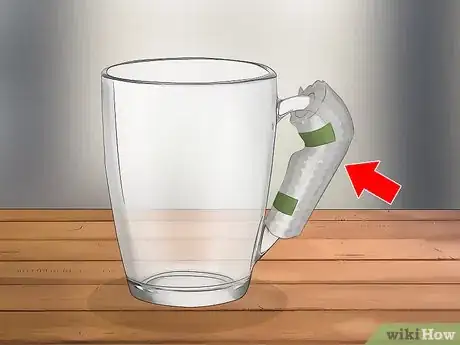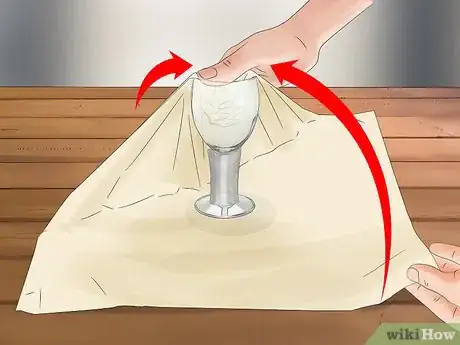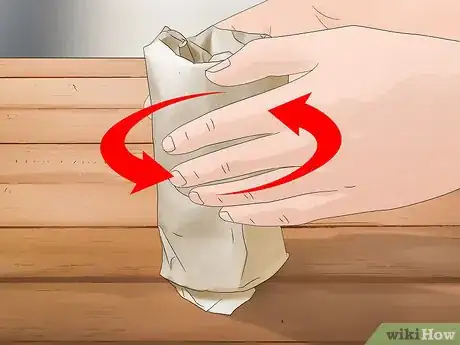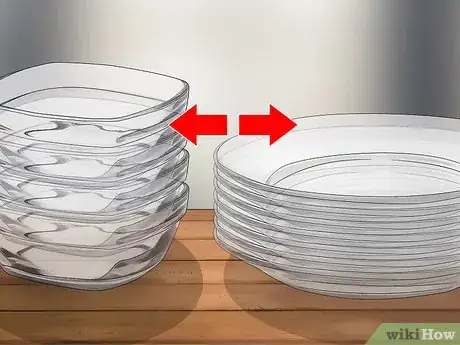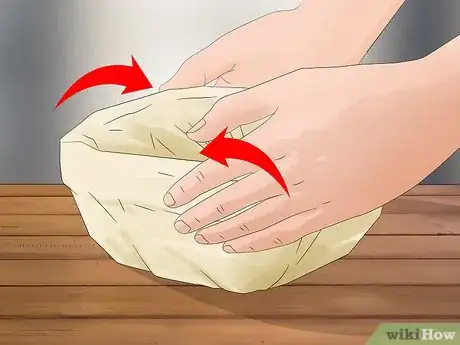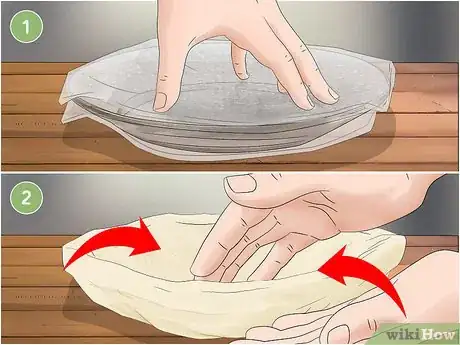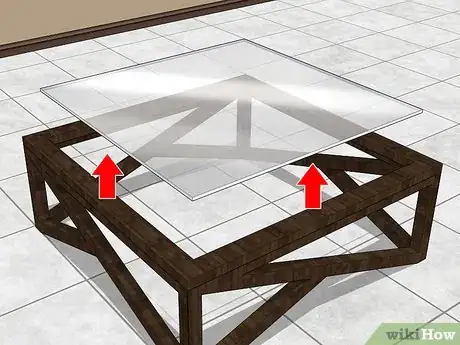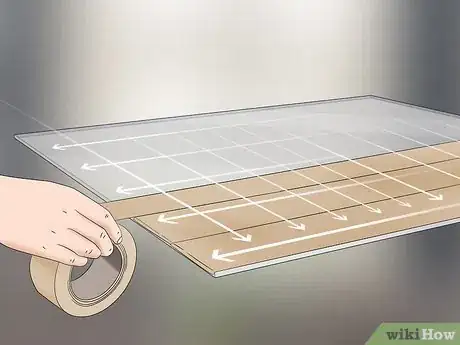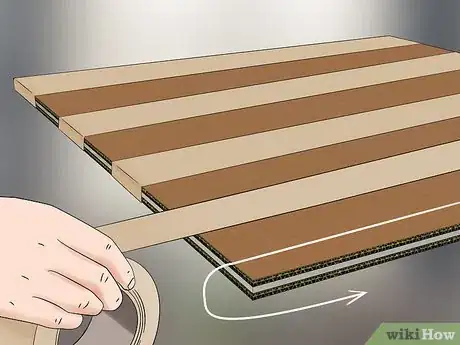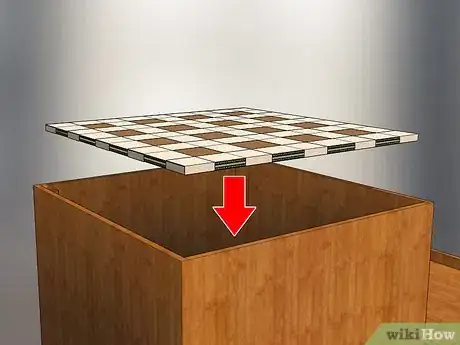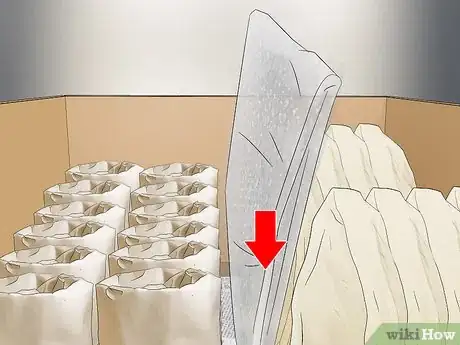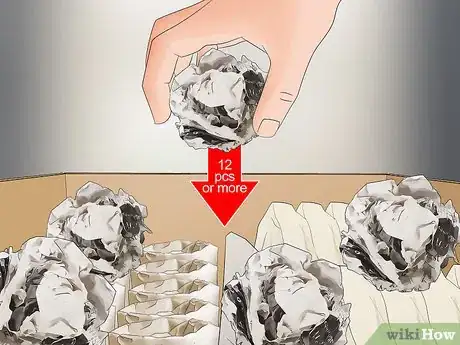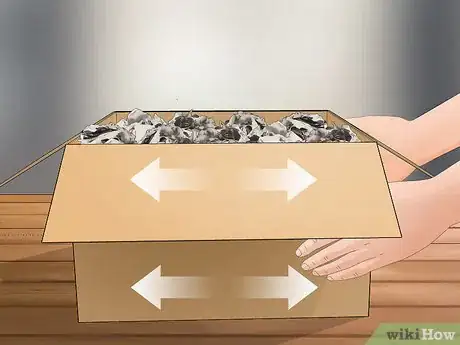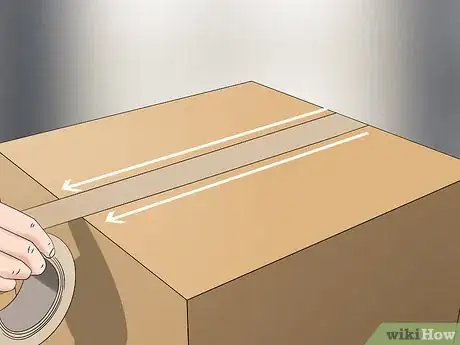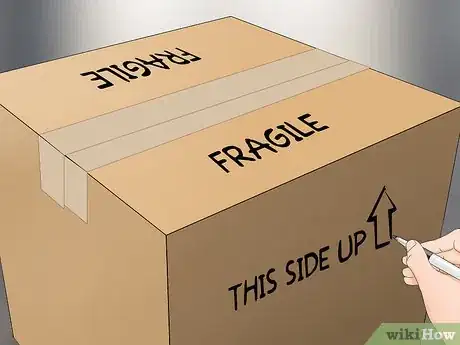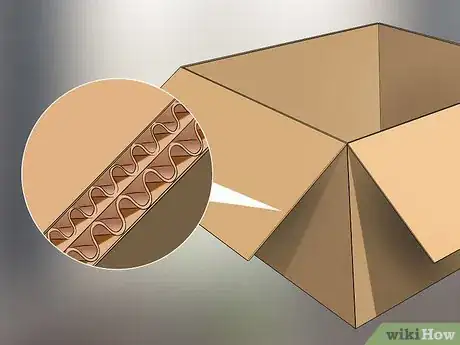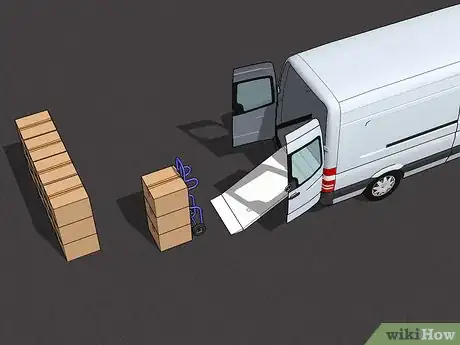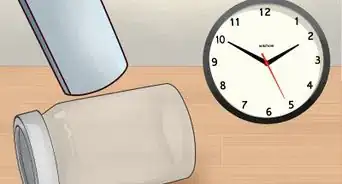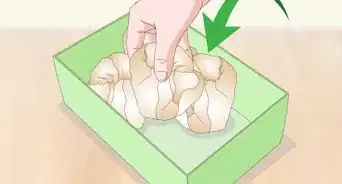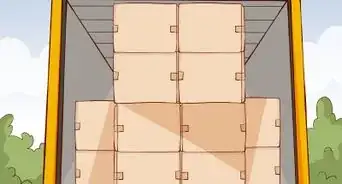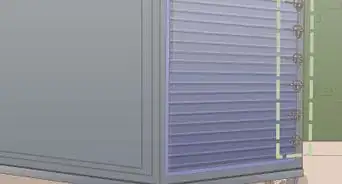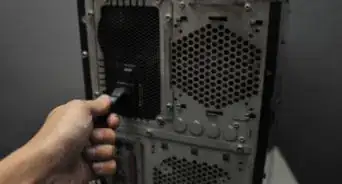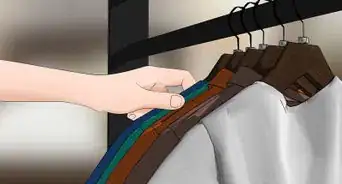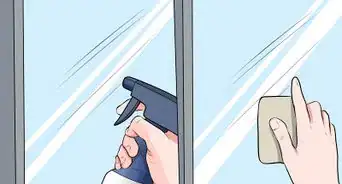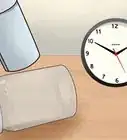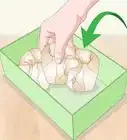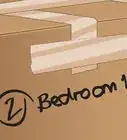This article was co-authored by Marty Stevens-Heebner, SMM-C, CPO®. Marty Stevens-Heebner was the first Certified Senior Move Manager (SMM-C) in the United States and is Founder and CEO of Clear Home Solutions, a move management and professional organizing company based in southern California. Marty is also a Certified Professional Organizer and a Certified Aging in Place Specialist (CAPS) through the National Association of Home Builders. She is the President-Elect and is on the board of directors of the National Association for Senior Move Managers, a member of the National Association of Professional Organizers, and has been acknowledged as a Hoarding Specialist and ADHD Specialist through the Institute for Challenging Disorganization.
There are 9 references cited in this article, which can be found at the bottom of the page.
This article has been viewed 18,499 times.
Moving or shipping glass without breaking it can seem like a challenge, but the packing process isn't too complicated. Each glass item needs to be rolled individually in packing paper before it is placed in a strong cardboard box. You will need newspaper, bubble wrap, or other material to fill the empty space in the box. Pack your glasses tightly in the box to protect them as they are transported.
Steps
Wrapping Cups and Wine Glasses
-
1Cover cup handles and other exposed areas with bubble wrap. Any area that juts out from the glass is a weak point.[1] Handles are the most obvious offenders, but also exposed rims, bases, or decorations are prone to breaking. Wrap a tight layer of bubble wrap around them. If you don't have bubble wrap, using packing paper or tissue paper can give these spots some extra cushioning.[2]
- Newspaper is also great for packing, but the ink may leave black smudges on glass. You are better off using newspaper as box filler instead of wrapping it around glass items.
-
2Wrap the stems of wine glasses with bubble wrap to widen them. A broken wine glass is a reminder of how delicate stemware is. To provide a buffer for the stem, cover it with a layer of bubble wrap. Continue wrapping until the bubble wrap is as wide as the glass' bowl and base. Tape the padding in place to ensure the stemware won't fracture when something bumps into it.[3]
- For the stems, use only bubble wrap. Other packing material may work in a pinch, but bubble wrap provides far more cushioning.
Advertisement -
3Stand your glasses on top of 3-ply packing paper. Packing paper is a soft material that won't damage your glass. Try to get 3-ply paper in order to provide plenty of protection for the glass. Set the glass in the center of the paper so that you can begin wrapping it.
- Get more paper than you think you will need, since excess paper can be used to provide additional protection for your package.[4]
- You can get packing paper wherever shipping supplies are sold, including from shipping companies and home improvement stores.
-
4Line the inner part of the glass with paper. To begin wrapping the glass, take 1 or 2 corners of the wrapping paper and insert it into the glass. Pull as much of the wrapping paper into the glass as possible. Avoid moving the glass off the paper while you do this.
- Another option is to crumple up a piece of paper and shove it into the glass. Fill the glass as much as you can, then wrap the outside separately.
-
5Wrap the remaining paper around the glass. Carefully pull the paper's other corners over the glass. Get the wrapping as tight around the glass as you can before taping it in place. Any space between the paper and glass can mean the difference between intact glassware and shards, so wrap extra paper around the glass if you need it.[5]
- Another way to do this is to position the glass at the edge of the paper, then roll it up. Make sure the inside part of the glassware remains filled.
- Usually packing paper provides enough protection, but you can fortify the glass with an additional layer of bubble wrap. Since bubble wrap is bulky, make sure you have enough space in your box for it!
- Glass vases are wrapped the same way as glassware. However, the size of many vases means you need to move them into a separate box or storage container.
Protecting Plates and Bowls
-
1Sort plates and bowls into sets before wrapping them. Package sets together. Not only does this spare you some confusion when you unpack the glass, but it also can be used for efficient packing. Similar plates and bowls can fit inside each other, giving them extra protection during the shipping process.[6]
-
2Wrap all items individually in packing paper. Wrapping glass plates and bowls is very similar to wrapping glassware. Set the plate or bowl on top of sheets of 3-ply packing paper. Pull 1 of the paper's corner all the way over the item. Then, tuck the other corners underneath the item and tape them together.[7]
- Make sure each piece of glass is wrapped up tightly. Use extra packing material as needed.
-
3Secure valuable items in an extra layer of bubble wrap. Break out the bulky bubble wrap, but don't pop those bubbles just yet! A thick piece of bubble wrap provides a pillowy cushion for your favorite items. Wrap the item tightly in at least 1 layer of bubble wrap, then use packing tape to hold the wrap in place.
- Bubble wrap is protective but takes up a lot of extra space in the box. You may have a harder time fitting items into a box and may need to split them into multiple boxes. Still, if you are worried about an item breaking, bubble wrap is worth using.
Securing Mirrors, Artwork, and Table Tops
-
1Separate glass components from furniture if they are detachable. Table tops and other large sheets of glass should be wrapped individually, if possible. Look for screws holding the glass to metal components on these items and undo them. Set the screws aside and label them so you can put your item back together later.
- The glass in mirrors usually is not detachable, so you will have to wrap it as is. Take precaution when packing and storing these items.
- Large pieces of glass are by far the most painful to handle. You may want to let a packing and shipping company handle them.
-
2Make a square grid over the glass surface with packing tape. First, apply rows of tape side by side all the way across the length of the glass. Cover the glass completely. Then, apply a second layer of tape side by side across the first layer of tape. Applying packing tape in a pattern helps prevent large sheets of glass from shattering.[8]
- Packing tape shouldn't leave a mark on glass. When the item reaches its destination, you can peel off the tape without a problem.
-
3Sandwich the glass between pieces of cardboard. Lay a piece of thick cardboard on the ground and position the glass over it. Cover it with a second piece of cardboard. Cardboard sheets can be purchased along with other packing supplies, or you can cut them out of larger cardboard boxes.[9]
- You may wish to measure your item first, so you know what sheet size you need.
-
4Wrap the package firmly with packing tape. Don't spare the tape here. Start by securing the tape to the lower layer of cardboard, then wrapping it all the way over and around to the other end. Do this multiple times until the cardboard layers are completely secure. Your glass may now look like a mummy, but the safety is worth it.[10]
- Try rattling the package before you finish. If you hear the glass moving, chances are the packing isn't tight enough. Tape the cardboard down as firmly as you can.
-
5Place the glass in a specialty cardboard box or wood crate. The final challenge for large pieces of glass is finding a box that fits them. You may need to look around a bit before you find a decent box. For extra-large or heavy pieces, shipping companies have wooden crates that provide additional support. Use these options to increase the chances of keeping your glass in 1 piece.[11]
- If you can't find a good box, make your own. Try flattening a cardboard box slightly larger than your item. Use a knife or scissors to open up 1 side of the box, then wrap the box around your item. Trim and tape the box to finish it.
Boxing Glass Items
-
1Tape the bottom of the box before putting glass in it. The last thing you want is for glass to shoot out the bottom of the box towards the waiting ground below. Assemble the box, flipping it onto its top side. Place a few layers of masking tape over the outer seams. Also tape the flaps together.[12]
- For additional security, add a layer of tape across the center of the box. This layer will cross over the tape holding the flaps together, forming a cross shape.
- All of this tape may seem like a lot, but you really need to make sure your box is stable before packing glass.
-
2Line the bottom of the box with newspaper or another soft material.[13] Newspaper is the ideal packing material because it is cheap, soft, and absorbent. Crumple up about 10 to 12 newspaper pages and drop them into your box. They will serve as a bottom cushion capable of absorbing sudden impacts.
- Other material will work too. Bubble wrap is great, although it takes up extra space. You can also use blankets, old clothing, or towels.
-
3Position glasses with the mouths facing downwards. Stand each individually-wrapped glass in the box, on top of the crumpled newspaper. Keep the glasses as close to each other as you can. The base of a piece of glassware is its strongest point, but the rim may break if you orient it upwards. Instead, leave the rim facing the box's bottom, where it can't move or bump the objects next to it.[14]
- You may feel tempted to lay the glass down in the box. While this can work, it also means you're stacking the glass, so the glass at the bottom may get crushed.
- For boxes with cells, all you have to do is put each glass rim-down in a cell. The cell divider will provide some extra cushioning.
-
4Stand glass plates up on their side. Similar to glassware, avoid laying plates and bowls flat in the box. Instead, rest them against the side of the box. Lean additional plates and bowls against them. Each item should be individually wrapped to provide plenty of cushioning.[15]
- If you have cell dividers big enough for plates, great. You can also use objects like Styrofoam, paint buckets, plate racks, or fabrics to provide extra support.
- When you lay plates flat in a box, they tend to move around a lot. Plates bumping together can lead to breakage. Also, the bottom plate may end up getting crushed.
- Similarly, avoid laying table tops and mirrors flat. Lay them against a wall, keeping heavy items away from them.
-
5Fit a layer of bubble wrap between rows of items. Doing this is useful if you have enough space to stack items in multiple rows or layers. Try to squeeze the bubble wrap between the items to prevent them from bumping into one another. If you don't have enough space for bubble wrap, you may be able to use packing tape, packing peanuts, fabric, or other buffers.
- Sometimes you can fit similar pieces of glassware over each other. Wrap the lower piece before putting it inside the bowl of the other piece, for instance.
-
6Place another layer of balled newspaper above the glass. Crumple up 9 to 12 more newspaper sheets and drop them over the glass. This fills the top half of the box, providing impact resistance in case it is turned upside down. Add more paper as needed if you notice any empty space remaining in the box.[16]
- Newspaper works well, but you can also use other packing material. Line the box with bubble wrap, blankets, or clothing if you prefer.
-
7Shake the box and listen for any signs of movement. Now comes the true test of your packing abilities. Give the box a good rattle to see if the glass bumps into anything. If you hear glass colliding into anything, whether it's other glass or the cardboard itself, your package isn't quite ready yet. Open it and fill it with more packing material.
- Look for any items that are packed too loosely. Rewrap them as needed. Consider adding a layer of bubble wrap or other packing material.
- If you see space in the box, fill it! Stuff in some bubble wrap, packing peanuts, or any other soft material you can think of.
-
8Close the box and tape it shut. Fold the top flaps over the box, then position the side flaps on top of them. Find your packing tape and seal up this end of the box. Seal the flaps together with a few layers of tape, then, for good measure, tape over the box's seams a few times.
- Tape across the center of the box and flaps to provide extra stability.
-
9Label the box with a dark marker. Use a black permanent marker to label the box. First, write “fragile” in big letters on the top of the box. Then, label the box so you know what is in it. Finally, write “this side up” so anyone who touches the box knows how to handle it safely.[17]
- For instance, you might write “kitchen glasses” on the box. This emphasizes that the box has delicate glasses in it, and it will also help you locate the box after it is moved.
Finding and Choosing Cardboard Boxes
-
1Use double wall corrugated cardboard boxes to pack glass. These are the sturdiest cardboard boxes you can get. Since a box of glass can get very heavy, the extra wall ensures that the box doesn't fall apart when you lift it. Corrugated simply refers to how the box is made. Pretty much all shipping containers are corrugated.[18]
- To make sure a box is corrugated, examine its edges. A corrugated box has a wavy layer of cardboard between 2 flat sheets. A double wall box will have a second layer of wavy and flat cardboard.
- Most regular, medium-sized cardboard boxes are fine to use, but make sure they aren't damaged and avoid overpacking them. These boxes will likely be single wall corrugated cardboard.
-
2Get dish barrel boxes to organize glass into separate cells.[19] Like the name suggests, these boxes are thick and strong to protect glass. Dividers section each box into separate compartments. Set a single glass item in each cell to give it the maximum amount of protection.[20]
- Companies that ship glass bottles or glassware often use this type of box, although a lot of shipping companies also sell them.
- Sometimes you can buy the cell dividers separately, then slide them into a cardboard box you already have.
-
3Purchase boxes from a moving company. Moving and shipping companies deal with packed boxes every day, so you know you can get all your supplies from them. Bring a list of the items you need to pack or figure out how many boxes you need. They will sell you both regular corrugated boxes and dish barrel boxes.
- They also may sell packing paper, packing tape, and bubble wrap, so consider getting all your supplies at the same time.
- If you have any problems packing your glass, ask the employees for tips. This can be especially helpful for large or oddly-shaped pieces such as table tops.
-
4Buy boxes and other moving supplies from retail stores. Various retail locations sell packing supplies. General stores often sell supplies, along with office supply stores and even some home improvement stores. The selection may not be as large as what a moving company offers, but general retail can be a way to get what you need all at once.
- You can also order boxes and other supplies online, although this won't help you too much if you need to pack in a hurry.
-
5Ask other people for packing boxes they no longer need. Plenty of shipping containers are used every day, so you might as well take advantage of them![21] If you know someone who has completed a move, ask for their leftover boxes. A lot of retail locations throw away their boxes and will let you take them for free if you ask as well.[22]
- To find available boxes in your area, look on https://www.freecycle.org/.
- Liquor stores are a good place to find strong boxes, as are book stores. However, don't overlook grocery stores, fast food stops, and other general retailers..[23]
Expert Q&A
-
QuestionWhere can I get packing paper?
 Marty Stevens-Heebner, SMM-C, CPO®Marty Stevens-Heebner was the first Certified Senior Move Manager (SMM-C) in the United States and is Founder and CEO of Clear Home Solutions, a move management and professional organizing company based in southern California. Marty is also a Certified Professional Organizer and a Certified Aging in Place Specialist (CAPS) through the National Association of Home Builders. She is the President-Elect and is on the board of directors of the National Association for Senior Move Managers, a member of the National Association of Professional Organizers, and has been acknowledged as a Hoarding Specialist and ADHD Specialist through the Institute for Challenging Disorganization.
Marty Stevens-Heebner, SMM-C, CPO®Marty Stevens-Heebner was the first Certified Senior Move Manager (SMM-C) in the United States and is Founder and CEO of Clear Home Solutions, a move management and professional organizing company based in southern California. Marty is also a Certified Professional Organizer and a Certified Aging in Place Specialist (CAPS) through the National Association of Home Builders. She is the President-Elect and is on the board of directors of the National Association for Senior Move Managers, a member of the National Association of Professional Organizers, and has been acknowledged as a Hoarding Specialist and ADHD Specialist through the Institute for Challenging Disorganization.
Professional Move Manager Generally, you can get recycled newspaper that's clean from a place that sells packing supplies.
Generally, you can get recycled newspaper that's clean from a place that sells packing supplies.
Warnings
- Newspaper is a handy packing material, but it can leave ink stains on glass. Avoid wrapping glass in it if possible.⧼thumbs_response⧽
Things You'll Need
Wrapping Cups and Wine Glasses
- Packing tape
- Packing paper
- Newspaper
- Bubble wrap
Protecting Plates and Bowls
- Packing tape
- Packing paper
- Newspaper
- Bubble wrap
Securing Mirrors, Artwork, and Table Tops
- Packing tape
- Packing paper
- Cardboard sheets
- Scissors or sharp knife
Boxing Glass Items
- Double wall corrugated cardboard box
- Packing tape
- Bubble wrap
- Black marker
References
- ↑ Marty Stevens-Heebner, SMM-C, CPO®. Certified Professional Organizer & Senior Move Manager. Expert Interview. 14 January 2020.
- ↑ https://www.apartmentguide.com/blog/how-to-pack-valuables/
- ↑ https://moving.tips/packing-tips/how-to-pack-glasses-for-moving/
- ↑ Marty Stevens-Heebner, SMM-C, CPO®. Certified Professional Organizer & Senior Move Manager. Expert Interview. 14 January 2020.
- ↑ https://moving.tips/packing-tips/how-to-pack-glasses-for-moving/
- ↑ http://www.unpakt.com/blog/top-5-ways-to-pack-dishes-during-a-move/
- ↑ https://moving.tips/packing-tips/how-to-pack-plates-for-moving/
- ↑ https://images.fedex.com/downloads/shared/packagingtips/howtopack.pdf
- ↑ https://www.apartmentratings.com/renters-library/7-tips-for-packing-mirrors.html
- ↑ https://www.apartmentratings.com/renters-library/7-tips-for-packing-mirrors.html
- ↑ https://www.apartmentratings.com/renters-library/7-tips-for-packing-mirrors.html
- ↑ https://moving.tips/packing-tips/how-to-pack-glasses-for-moving/
- ↑ Marty Stevens-Heebner, SMM-C, CPO®. Certified Professional Organizer & Senior Move Manager. Expert Interview. 14 January 2020.
- ↑ https://moving.tips/packing-tips/how-to-pack-glasses-for-moving/
- ↑ http://www.unpakt.com/blog/top-5-ways-to-pack-dishes-during-a-move/
- ↑ https://moving.tips/packing-tips/how-to-pack-glasses-for-moving/
- ↑ https://moving.tips/packing-tips/how-to-pack-glasses-for-moving/
- ↑ https://www.youtube.com/watch?v=OOVTsNFOIPE
- ↑ Marty Stevens-Heebner, SMM-C, CPO®. Certified Professional Organizer & Senior Move Manager. Expert Interview. 14 January 2020.
- ↑ https://moving.tips/packing-tips/how-to-pack-glasses-for-moving/
- ↑ Marty Stevens-Heebner, SMM-C, CPO®. Certified Professional Organizer & Senior Move Manager. Expert Interview. 14 January 2020.
- ↑ https://www.apartmenttherapy.com/8-spots-to-get-moving-boxes-fr-1-103420
- ↑ Marty Stevens-Heebner, SMM-C, CPO®. Certified Professional Organizer & Senior Move Manager. Expert Interview. 14 January 2020.
